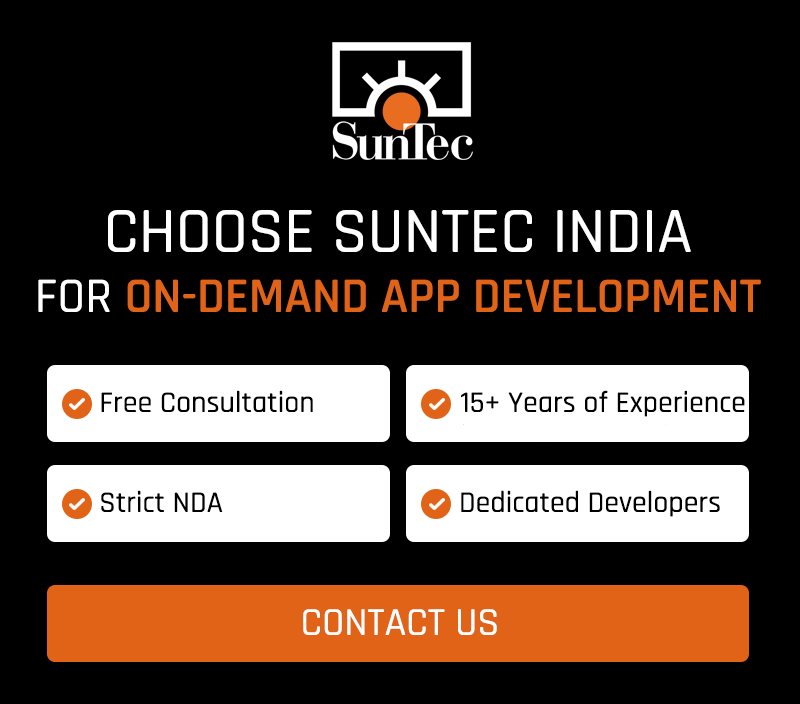![How-Do-I-Create-An-App-Like-UberEats-or-Deliveroo [Updated 2022] How-Do-I-Create-An-App-Like-UberEats-or-Deliveroo [Updated 2022]](https://www.suntecindia.com/blog/wp-content/uploads/2022/04/How-Do-I-Create-An-App-Like-UberEats-or-Deliveroo.png)
UberEats, DoorDash, and GrubHub are the biggest contemporary examples of profitable and successful on-demand food delivery app development projects. If you want to build a similar mobile app solution, the first step is to identify and address the biggest roadblocks on that path.
- Would a food delivery app built exactly like UberEats get the same traffic, reach, and ROI?
- How will you stand out from other businesses building similar food delivery solutions?
- Can you build an app like UberEats or Deliveroo while ensuring a positive ROI?
- How to minimize the cost of this process through mobile app development services?
In this article, we will build on these challenges, examine UberEats, understand its intricacies, and devise steps to build a similar food delivery app.
Top Food Delivery Apps In The USA
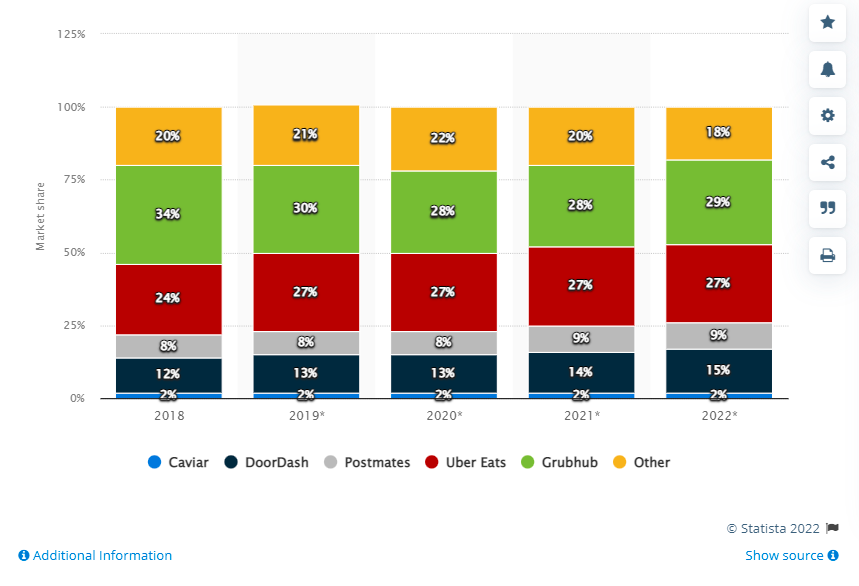
How To Create Food Delivery Apps Like UberEats?
- A Step-By-Step Guide To Build A Food Delivery App Like UberEats
- How Much Does It Cost To Make A Mobile App Like UberEats And Deliveroo?
- Must-Have Features When Developing A Food Delivery App Like UberEats
- How To Choose A Technology For On-Demand Food Delivery App Development
- How To Stand Out Amidst Competition With Your Food Delivery App?
- How Can We Help You?
A Step-By-Step Guide To Build A Food Delivery App Like UberEats
Before we get into the nuances of creating a food delivery app, take note of the process we follow. While it can be expanded into several dimensions, the gist of on-demand food delivery app development remains within these steps.
- Research your target niche and create an ideal customer profile
- Choose a business model
- Aggregator-based delivery
- Logistic partner-based delivery
- Identify the key components of your business model
- Customers
- Restaurants
- Drivers
- Curate an optimal list of features for all key users
- Research about latest food delivery market trends
- Add unique value propositions to your app
- Choose a technology stack
- Determine user targeting channels
- Desktop
- Mobile
- Social media
- Support channels
- Determine revenue streams
- Delivery fee from users
- Delivery fee from restaurants
- Order placement fee
- Advertising fee from restaurants
- Premium service fee from all users
- Compute food delivery app development cost
Further, we’ll discuss:
- Food delivery app development cost
- Must-have features for a food delivery app
- Technology stack to develop an app like UberEats
- The need for food delivery apps in a market with so many of them (and how to stand out from the competition)
How Does UberEats Make Money?
UberEats charges restaurants a fee for each order. This fee depends on the plan they choose.
- Lite: 15% on delivery orders | 6% on pickup
- Plus: 25% on delivery orders | 6% on pickup
- Premium: 30% for delivery orders | 6% on pickup
It also uses other revenue streams like self-delivery (15% fee,) paid ads on Uber, dynamic pricing (surge,) and a sales management WebShop.
How Much Does It Cost To Make A Mobile App Like UberEats And Deliveroo?
What are the prime factors that will determine your expense? How much does it cost to build an app like Deliveroo? Or UberEats? Or DoorDash?
And what if you do not have a similar budget?
Do not worry! And stop looking for current UberEats expenses to get a grasp on how much you might end up spending.
Instead, assess the cost of on-demand food delivery app development much like you would for any mobile app development service.
- Create a user story map for every planned portal
- Divide the feature set into categories (to be developed now and added later)
- Assign development time to each map/module accordingly
- Determine cost of development for each module
- Determine maintenance cost and upgrade costs for the current development cycle
- Adjust by location (in case you outsource mobile app development services)
- Adjust by resource (in case you hire dedicated software developers)
- Adjust for infrastructure cost, IT support, data storage, APIs, servers, and compliances
Therefore, explore your service diversification before anything. That will help you understand your solution better, leading to more acute cost estimation.
For instance, look at this user story map (unrelated from our application’s nature but essential to understand how user maps help define the development storyline, feature set, and development cost.)

However, when working over food delivery app development costs, you need to focus on one factor more than the others.
Who Will Develop Your App?
- You can hire dedicated software developers in-house
- You can hire freelance resources for a limited period
- You can delegate the entire project to a mobile app development services provider
The cost for each- monetary and effort-wise -differs.
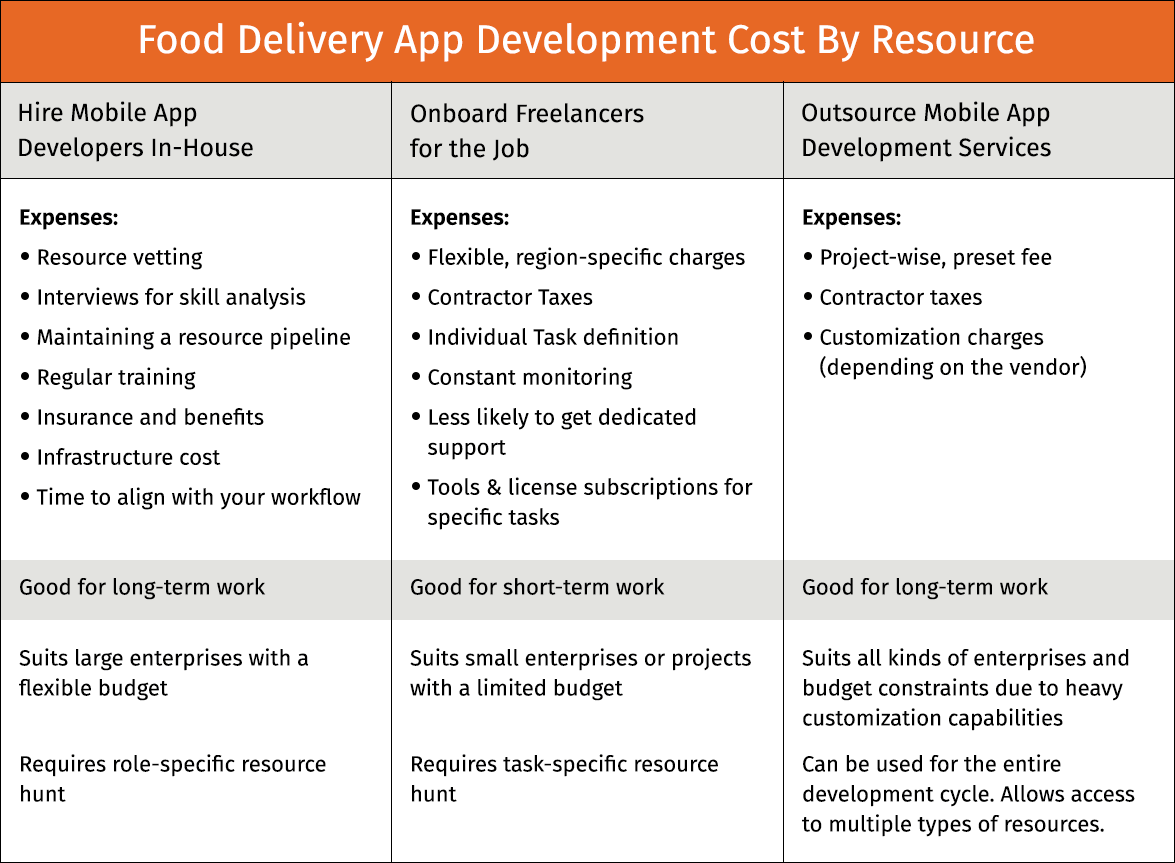
Must-Have Features When Developing A Food Delivery App Like UberEats
How do you choose the feature set for your food delivery app?
Studies show that customers do not stay loyal to any single meal delivery service. They only go wherever the discounts & prices are better, the app experience friendly, and the stakes more in their favor.
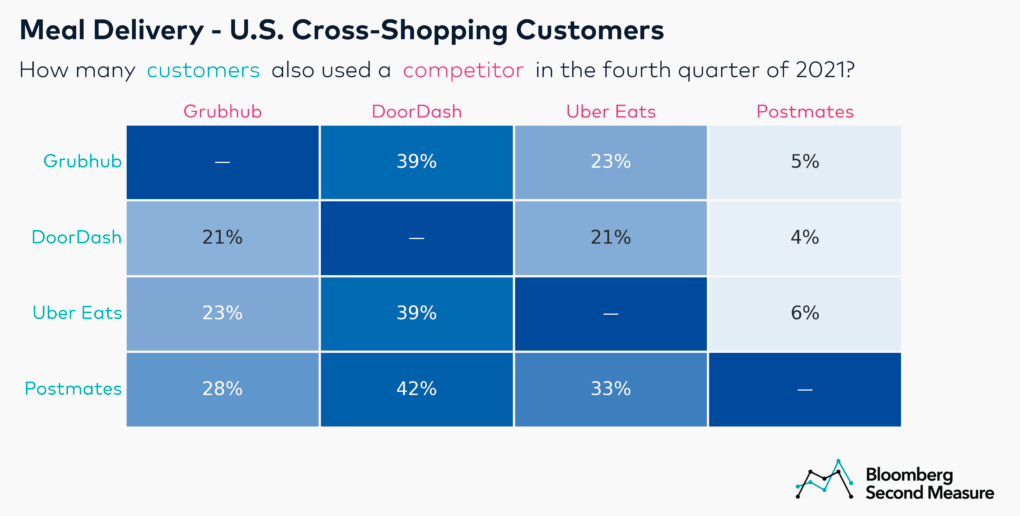
So, the choice of features will not single-handedly promise a customer’s attention to your app. But, it is a prime differentiator when it comes to the competition in food delivery markets.
A seamless experience- that is what customers of today desire.
So, even though we are giving you a list of the must-have features that apps like UberEats & Deliveroo possess, do not treat this as absolute. We recommend a behavioral analysis for your target market to better understand what their definition of an interface looks and feels like.
1. Simplified Sign-up
A sign-up form is any user’s first step towards actually getting into a deal with your platform. If you can convince them to create an account, they become a part of your ROI.
However, many businesses falter here, mostly because of a poorly designed sign-up and log-in page.
Nobody has the patience for long registration forms, hour-long verifications, and remembering new passwords.
- 86% of users feel bothered by tedious account creations processes on the web
- 54% of users prefer switching websites/apps than creating accounts via lengthy processes
- 92% of users will let an account stale out or leave it unattended than recover or reset their passwords
The solution- a straightforward, two-step sign-up process and simplified login.
- Allow login via email addresses
- Accept sign up via social media accounts
- Facilitate password resetting via emails or social accounts
- Keep your manual registration form short
- Offer ‘remember password’ solutions
Also, we must talk about confirmation emails.
Most food delivery apps like UberEats send a link to the user’s email. Once clicked, it verifies the email and activates the user’s account. However, often, these emails end up in spam, reach too late, sometimes do not reach the user, or contain broken links.
Our advice- Double check that system before you go live.
2. Uncomplicated Order Placement & Checkout Process
Ordering is the prime purpose of a food delivery app. It is what you sell as a platform.
The simpler it is, the better.
If you intend to create food delivery apps like UberEats & Deliveroo, borrow some inspiration from how they integrate order scheduling, payment, discounts, item addition, and grouping in a single page.
Their order placement workflow is simple.
- Choose a restaurant
- Choose from menu items
- Add payment
- Add address
- Add related items on the checkout page
- Apply discounts on the checkout page
- Pay and confirm order
When implemented, this workflow answers every user’s needs in plain sight.
It gives them choices to add or change addresses and payment methods, cross-sells by providing an AI-powered recommendation bar, and entices them with a discount menu- all on the checkout page.
Additionally, you can improve the order placement process with features like:
- Filters to enhance the search experience
- Note-based personalizations
- Order scheduling (if the restaurant offers such a service)
- ‘Repeat’ option on the order history
Why is this important?
Because a complicated checkout process is one of the top three reasons for cart abandonment. The right checkout design can help you reduce that risk by 35%. In fact, that has helped the industry save nearly $260 billion in recovered orders.
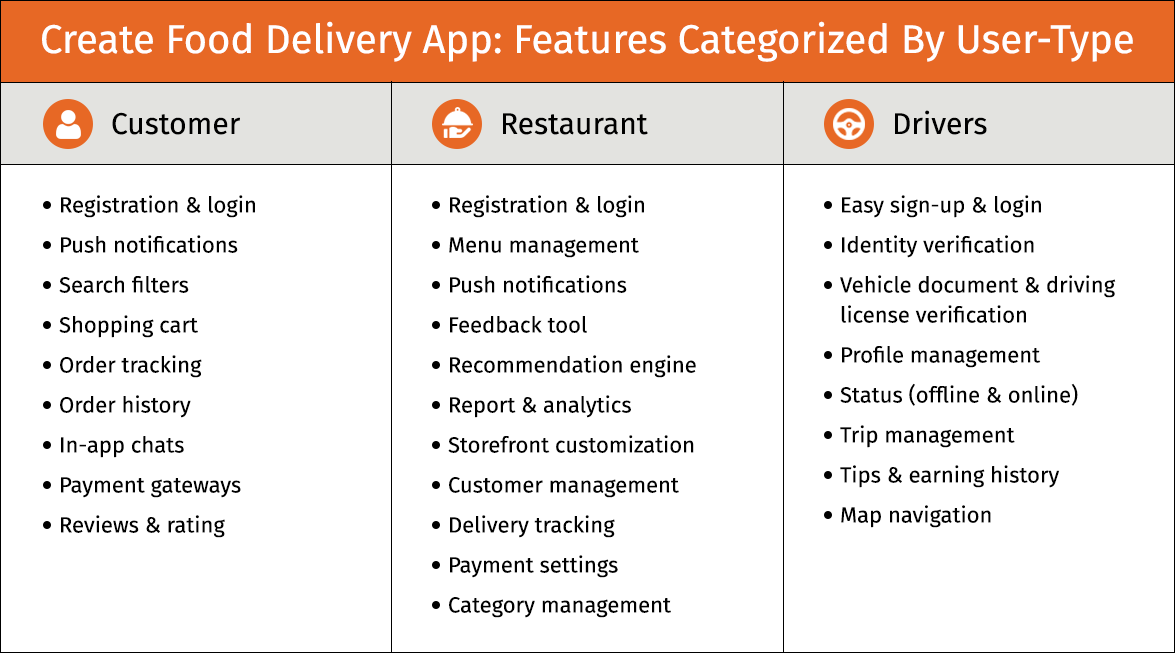
3. Categorize. Segment. Make Browsing Easier.
Whatever the technicalities of an on-demand food delivery app may be, it is all about food in the end.
Your customer is hungry, or craving something specific. Do not make them go through a long list before reaching their coveted item, because they will not.
Think about it- only 25% of people ever go to the second page on Google results. Why would they browse through more than two or three screens on your food delivery app, then?
The idea behind all the top food delivery apps in the USA (or anywhere, really) is to create a platform where a group of restaurants can flaunt their offerings. Naturally, you will attract a crowd. Categorization is the best way to help your audience navigate that crowd and reach their destination in less time and fewer attempts.
This categorization should, ideally, be applied on the search console results as well as on the individual page for restaurants. You can-
- Group search results by cuisine
- Break menus into blocks by category
- Create popular sections for items in demand
- Allow customization choices so the users can create their favorite filters
- Allow filters in the search bar, like rating, reviews, cost, timing, distance, etc.
4. User Support
If you create food delivery apps on the Aggregator model, you will be the mediator between restaurants and customers. If you use the Logistics approach, you will still be the mediator.
Only now, you will also manage a fleet of drivers.
The key to keeping this equation simple and every entity in it satisfied is through a communication system that is hyper-transparent and quick as light.
- Allow every stakeholder a way to contact you directly and quickly
- Create an effective driver tracking tool for users and restaurants and admins
- Use a chat integration so the users & drivers & restaurants can talk to you
Establishing effortless communication between so many parties usually comes with its own set of feature requirements. That includes push notifications, chatbots, device responsiveness, etc.
Research on that and keep in mind, the goal here is to help all involved parties to keep in touch for any particular order.
Essential Features Of A Food Delivery App

Want to Create an On-demand Solution for Your Business?
How To Choose A Technology For On-Demand Food Delivery App Development
Even though this decision boils down to choices like Android or iOS, Swift or Java or HTML5, that is only a basic requirement.
Any present-day food delivery app has several dimensions angled towards creating a 360-degree customer experience. You have to create high-end features to satisfy a customer that’s expecting endless convenience.
Therefore, you will need to take the choice of technologies a few notches higher.
Examples include:
- Artificial Intelligence
- AR & VR
- Integration with intelligent devices (like watches)
- Online (touch & tap) payment gateway integrations
Then again, the type of food delivery app you create will also influence the mixture of technologies you choose.
Primarily, you will find two types of food delivery applications in the market.
- Aggregators
- New Delivery
1. Aggregators
A food delivery app created on the Aggregator model connects a user with multiple restaurants on a single platform.
The platform does not handle the delivery. It only offers a place where users can look at menus, prices, and other information about multiple diners and place an order.
In this case, since the delivery is handled by a restaurant, the food delivery app only collects a fixed amount of fee.
Components: User-side portal, restaurant-side portal
Example: GrubHub, FoodPanda, Delivery Hero, Just Eat
2. New Delivery/Logistics
These types of food delivery applications provide every service included in an Aggregator, plus one.
The delivery logistics.
If you create a new food delivery application using this model, you (i.e., the platform) will have to maintain a fleet of vehicles and drivers. You will also need to manage them for optimized performance.
Food delivery apps like these charge in two ways.
- A fixed fee on the order
- A small fee from the customer
Components: User-side portal, restaurant-side portal, deliver personnel/driver portals
Example: UberEats, DoorDash, Deliveroo
How To Stand Out Amidst Competition With Your Food Delivery App?
Take a look at the best value propositions of UberEats.
- A hybrid between aggregator, platform, and on-demand models
- Accessibility and convenience
- Frequent price reductions for users
- Better brand reputation for restaurants
This is what you need to discover.
A certain advantage to all end-users; a USP that raises you above the competition. Something that you can do better than the others. Something that nobody else does.
Finding a USP to add to your food delivery app is a matter of extensive niche market research. You must know what your targets crave. It could be:
- Faster delivery in a localized region
- Widespread delivery to far-out areas
- Better driver incentives
- Enhanced marketing opportunities
- Taste-dependent restaurant list curation
There is no end to experimentation here. So, research, observe, and test out ideas with your team.
Also Read: Cost and features to build an on-demand food ordering app like GrubHub
How Can We Help You?
What is the trick to successful on-demand food delivery app development?
You must have absolute clarity on the following.
- The application’s look, feel, behavior, and utility
- Time to be invested in the development process
- The niche target market where the app will find its initial audience
- Total attainable budget
- Basic ROI expectations
- The team/people responsible for developing the application
You can do it yourself. But even with expertise, that will involve a lot of time and effort. You can do this in-house as long as you have a team of developers well established in all the aspects you need for this project.
Or, you can hire iOS app developers & Android developers (basically, any kind of mobile app development services) from a third party.
If you choose to hire mobile app developers from an established IT support company, you will save over 50% of the 0 effort involved here, plus as much as 60% cost savings.
That’s Where We Come In
The SunTec India team specializes in on-demand food delivery app development. We can help you in this case with a combination of different services, including:
- iPhone app development services
- Android app development services
- Marketing & SEO services
- Web research & data mining services
- Retail data research and social media research
- Data Analytics & Database Management
- Cloud Services Creation & Support
- Data Support For AI & ML
To leverage our 25+ years in the industry and join our band of 7800+ global clients, all you need to do is talk to us. Even if you just have a doubt about how to create food delivery apps, drop them in the comments or send an email our way.
![How Do I Create An App Like UberEats or Deliveroo? [Updated 2022]](https://www.suntecindia.com/blog/wp-content/uploads/2022/04/fii2.png)
